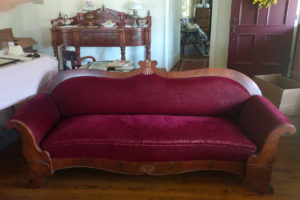 GB sends me a photo of an American Empire sofa from the early to mid-19th century. Since I receive many questions of value for this furniture style, I bearer the bad news of its unfavorability in today’s market. Yet I’ve always loved this period and loved it for what it says to me about our history.
GB sends me a photo of an American Empire sofa from the early to mid-19th century. Since I receive many questions of value for this furniture style, I bearer the bad news of its unfavorability in today’s market. Yet I’ve always loved this period and loved it for what it says to me about our history.
What you sit on, use every day, eat with, or wear reflects the values, philosophy and economics of a certain era. Look at the lines of this sofa. It tells you something about security and solidity. It seems somehow ‘classical’ like the architecture of a bank with classical columns and a great heavy staircase. This ‘classical’ style reflects Greek and Roman architectural motifs.
Its mass and weight conveys permanence and stability. Americans told ourselves about our future in the early to mid-19th century. And our architecture and furniture and home interiors reflected our vision of ourselves.
To judge American Empire furniture for its true value, I look for somber shapes that seem sarcophagus-like. Architectural forms like pedestals, and heavy bases, feature in this style. If the style looks heavy, it’s because it IS. This furniture isn’t elegant, simple, or linear. This is because the style that came before American Empire WAS elegant and linear. And most styles in the history of design are a reaction against a previous style.
Previous American furniture admired and reproduced the British styles, such as Chippendale, Hepplewhite, and Sheraton forms, BUT by the 1820-30’s we KNEW we were not beholden to the British. In fact, we admired the French, and their style of furniture. We were politically aligned with the French, and well as decoratively aligned with the French.
The reason the American Empire style is called ‘empire’ is that America was becoming an empire, economically, expanding into the West, building railroads, conquering other Peoples, building the great cities, with their banking empires. So we wanted a style that reflected our serious, firm, stalwartly classic natures. Therefore we wanted a sofa that endured.
Other eras had also used the lines and shapes of architecture in furniture for the manor or the home to declare “Empire,” notably the French, under Napoleon. This happened after the French revolution, a period called the French “republic,” named after the precedents in the Greek and Roman Republics. So the language of the style borrowed the classic look of the Roman Republic. And so did Napoleon who crowned himself an Emperor, who LOVED the Roman styles. Hence, the term in France and America for this furniture is the “empire” style.
 Indeed, the US allied with France after the French Revolution and adopted this “empire-related” cultural language, however, as the US grew into the 1830-1840’s, we became aware that we had become indeed mighty. Thus, OUR version of Empire furniture grew heavy, more ponderous than the French Empire, and it became serious. The America Empire style is always dark, executed in serious mahogany and carved elements in dark wood. It echoed American Imperialism (like Imperial Rome) and the Imperial philosophy, which stated that America was indeed the New Republic. And we became dominant and permanent on the World map.
Indeed, the US allied with France after the French Revolution and adopted this “empire-related” cultural language, however, as the US grew into the 1830-1840’s, we became aware that we had become indeed mighty. Thus, OUR version of Empire furniture grew heavy, more ponderous than the French Empire, and it became serious. The America Empire style is always dark, executed in serious mahogany and carved elements in dark wood. It echoed American Imperialism (like Imperial Rome) and the Imperial philosophy, which stated that America was indeed the New Republic. And we became dominant and permanent on the World map.
This furniture reflects all of that, and yet it cost a lot. This last era of handmade furniture became known for the use of expensive hand worked veneers to show off wood grains. In fact, veneering is sometimes the only decorative element, opposed to French style bronzes, on a piece of furniture.
The sofa pictured here says, “I can accommodate the prosperous citizens of a new imperial republic.” And indeed the idea of the republic, modeled on the Roman, became significant from our founding in the 18th century. American Empire furniture made the restatement of this philosophy in more ponderous, prosperous, weighty terms, of that philosophy. We called this Neo-Classicism.
The style, because of its heavy mass, stood up to the years, and is NOT rare in the market. That’s one of the reasons the market does not think it desirable. Because Americans made this furniture to proclaim permanence, it also proclaims it posses a future. However, the market doesn’t see what I see in the philosophy of the furniture, and GB’s sofa is worth under $500. I wish the market didn’t considered this style. “ heavy and dark.”
American Empire furniture is simply Empire furniture that was made in America. “Empire” refers to the period in France between 1800 and 1815 when Napoleon was in power. https://en.wikipedia.org/wiki/Empire_style
I love American Empire furniture. I’m “rebuilding” a sofa right now. I also love Eastlake. So Empire and Eastlake are what I’m replacing all my IKEA-ish stuff with. It’s sturdy, both are inexpensive on the market and they will last another 100 years.